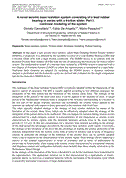[1]
Mostaghel, N., Khodaverdian, M., Dynamics of resilient-friction base isolator (R-FBI), Earthquake Engineering & Structural Dynamics, Vol. 15, pp.379-390, (1987).
DOI: 10.1002/eqe.4290150307
Google Scholar
[2]
Gueraud, R., Noel-Leroux, J.P., Livolant, M., Michalopoulos, A.P., Seismic isolation using sliding elastomer bearing pads, Nuclear Engineering and Design, Vol. 84, pp.363-377, (1985).
DOI: 10.1016/0029-5493(85)90252-3
Google Scholar
[3]
Cancellara, D., Pasquino, M., A new passive seismic control device for protection of structures under anomalous seismic events, Applied Mechanics and Materials, Vol. 82, pp.651-656, (2011).
DOI: 10.4028/www.scientific.net/amm.82.651
Google Scholar
[4]
Jangid, R.S., Kelly, J.M., Base isolation for near-fault motions, Earthquake Engineering & Structural Dynamics, Vol. 30, pp.691-707, (2001).
DOI: 10.1002/eqe.31
Google Scholar
[5]
Yang, Y.B., Lee, T.Y., Tsai, I.C., Response of multi-degree-of-freedom structures with sliding supports, Earthquake Engineering & Structural Dynamics, Vol. 19, pp.739-752, (1990).
DOI: 10.1002/eqe.4290190509
Google Scholar
[6]
Cancellara, D., De Angelis, F., Pasquino, V., Displacement based approach for the seismic retrofitting of a RC existing building designed for only gravitational loads, Applied Mechanics and Materials, Vol. 166-169, pp.1718-1729, (2012).
DOI: 10.4028/www.scientific.net/amm.166-169.1718
Google Scholar
[7]
Cancellara, D., Pasquino, M., Performance Based Design according to EC8: Fixed-Base vs. Base-Isolated RC frame structures (in Italian), Ingegneria Sismica, Vol.26 (2), pp.50-61, (2009).
Google Scholar
[8]
Cancellara, D., Pasquino, M., Base isolated building with hybrid base isolation system (HDRB & FS in parallel): Linear vs. Nonlinear dynamic analysis (in Italian), Ingegneria Sismica, Vol.27 (3), pp.17-32, (2010).
Google Scholar
[9]
Cancellara, D., De Angelis, F., Steel braces in series with hysteretic dampers for reducing the seismic vulnerability of RC existing buildings: assessment and retrofitting with a non-linear model, Applied Mechanics and Materials, Vol. 204-208, pp.2677-2689, (2012).
DOI: 10.4028/www.scientific.net/amm.204-208.2677
Google Scholar
[10]
Cancellara, D., De Angelis, A nonlinear analysis for the retrofitting of a RC existing building by increasing the cross sections of the columns and accounting for the influence of the confined concrete, Applied Mechanics and Materials, Vol. 204-208, pp.3604-3616, (2012).
DOI: 10.4028/www.scientific.net/amm.204-208.3604
Google Scholar
[11]
Park, Y.J., Wen, Y.K., Ang, A.H-S., Random Vibration of Hysteretic Systems under Bi-Directional Ground Motions, Earthquake Engineering and Structural Dynamics, Vol. 14, pp.543-557, 1986.
DOI: 10.1002/eqe.4290140405
Google Scholar
[12]
Nagarajaiah, S., Reinhorn, A.M., Constantinou, M.C., 3D-Basis: Nonlinear Dynamic Analysis of Three-Dimensional Base Isolated Structures: Part II, Technical Report NCEER-91-0005, National Center for Earthquake Engineering Research, Buffalo, N.Y., 1991.
Google Scholar
[13]
Mokha, A., Constantinou, M.C., Reinhorn, A.M., Teflon bearings in a seismic base isolation: experimental studies and mathematical modelling, Technical Report No. NCEER-88-0038, National Center for Earthquake Engineering Research. Buffalo, N.Y., 1988.
Google Scholar
[14]
De Angelis, F., An internal variable variational formulation of viscoplasticity, Computer Methods in Applied Mechanics and Engineering, Vol. 190, n. 1-2, pp.35-54, (2000).
DOI: 10.1016/s0045-7825(99)00306-0
Google Scholar
[15]
De Angelis, F., A variationally consistent formulation of nonlocal plasticity, Int. Journal for Multiscale Computational Engineering, Vol. 5, n. 2, pp.105-116, (2007).
DOI: 10.1615/intjmultcompeng.v5.i2.40
Google Scholar
[16]
De Angelis, F., Multifield potentials and derivation of extremum principles in rate plasticity, Materials Science Forum, Vol. 539-543, pp.2625-2630, (2007).
DOI: 10.4028/www.scientific.net/msf.539-543.2625
Google Scholar
[17]
De Angelis, F., On constitutive relations in non-smooth elasto/viscoplasticity, Advanced Materials Research, Vol. 566, pp.691-698, (2012).
DOI: 10.4028/www.scientific.net/amr.566.691
Google Scholar
[18]
De Angelis, F., Evolutive laws and constitutive relations in nonlocal viscoplasticity, Applied Mechanics and Materials, Vol. 152-154, pp.990-996, (2012).
DOI: 10.4028/www.scientific.net/amm.152-154.990
Google Scholar
[19]
De Angelis, F., A comparative analysis of linear and nonlinear kinematic hardening rules in computational elastoplasticity, Technische Mechanik, Vol. 32, n. 2-5, pp.164-173, (2012).
Google Scholar
[20]
De Angelis, F., Cancellara, D., Constitutive equations for a model of nonlocal plasticity which complies with a nonlocal maximum plastic dissipation principle, Applied Mechanics and Materials, Vol. 217-219, pp.2362-2366, (2012).
DOI: 10.4028/www.scientific.net/amm.217-219.2362
Google Scholar
[21]
De Angelis, F., Cancellara, D., A consistent formulation of constitutive relations for a model of nonlocal viscoplasticity, Applied Mechanics and Materials, Vol. 217-219, pp.2367-2372, (2012).
DOI: 10.4028/www.scientific.net/amm.217-219.2367
Google Scholar
[22]
De Angelis, F., Computational issues in rate dependent plasticity models, Advanced Materials Research, Vol. 566, pp.70-77, (2012).
DOI: 10.4028/www.scientific.net/amr.566.70
Google Scholar
[23]
De Angelis, F., Computational aspects in the elasto/viscoplastic material behavior of solids, Advanced Materials Research, Vol. 567, pp.192-199, (2012).
DOI: 10.4028/www.scientific.net/amr.567.192
Google Scholar
[24]
De Angelis, F., Numerical algorithms for J2 viscoplastic models, Advanced Materials Research, Vol. 567, pp.267-274, (2012).
DOI: 10.4028/www.scientific.net/amr.567.267
Google Scholar
[25]
De Angelis, F., Cancellara, D., Modano, M., Pasquino, M., The consequence of different loading rates in elasto/viscoplasticity, Procedia Engineering, Vol. 10, pp.2911-2916, (2011).
DOI: 10.1016/j.proeng.2011.04.483
Google Scholar
[26]
De Angelis, F., Cancellara, D., Implications due to different loading programs in inelastic materials, Advanced Material Research, Vol. 422, pp.726-733, (2012).
DOI: 10.4028/www.scientific.net/amr.422.726
Google Scholar
[27]
De Angelis, F., Cancellara, D., Results of distinct modes of loading procedures in the nonlinear inelastic behavior of solids, Advanced Material Research, Vol. 482-484, pp.1004-1011, (2012).
DOI: 10.4028/www.scientific.net/amr.482-484.1004
Google Scholar
[28]
Cancellara, D., De Angelis, F., Seismical protection properties of high damping rubber bearing and lead rubber bearing base isolation systems for multi-storey RC buildings, Applied Mechanics and Materials, Vol. 234, pp.90-95, (2012).
DOI: 10.4028/www.scientific.net/amm.234.90
Google Scholar
[29]
Cancellara, D., De Angelis, F., Dynamic nonlinear analysis of an hybrid base isolation system with viscous dampers and friction sliders in parallel, Applied Mechanics and Materials, Vol. 234, pp.96-101, (2012).
DOI: 10.4028/www.scientific.net/amm.234.96
Google Scholar

